What is a temporary site access road?
Temporary site access roads are regularly required on construction sites. Also known as temporary haul roads, they provide access for what can be heavy construction vehicles carrying materials and equipment needed to complete the project at hand.
Because these roads are required only temporarily, they tend to be constructed from a granular fill or aggregate placed on existing ground. The granular fill or aggregate acts as the road surface itself.
Temporary site access roads can be as short as a few tens of metres or long enough to extend several kilometres (for example, to allow access for the construction of wind farms).
Temporary access road design and construction methods
Although an access road may only be needed for a short period—say six months—it should be designed based on the anticipated traffic load it will carry over its operational life.
An access road design assessment will take several factors into account for the site under consideration:
• Existing ground strength—normally expressed as a California Bearing Ratio (CBR), undrained shear strength or stiffness modulus
• Anticipated traffic load—expressed as a number of vehicle visits of differing type and configuration (e.g. concrete mixers, steel delivery vehicles) from which a number of Equivalent Standard Axle Loads (ESAL’s) can be calculated*
• Granular fill grading — This refers to the quality of the aggregate used to build the road and would typically be classified using a particle size distribution curve
• Target surface deformation or rut depth — A serviceability target for the road surface after trafficking
*It’s important to recognise that before the traffic for the main construction project uses these temporary roads, vehicles delivering the granular fill to build the access road itself will need to use them too. This means the critical time for building an access road is the construction phase itself, where the vehicles delivering the granular fill are travelling at their closest point to the subgrade soils.
The temporary haul road design procedure identifies what thickness of granular fill is needed to carry the traffic load. The traffic load is based on a surface deformation target established using a method of calculation derived from empirical data.
In the UK, the granular foundation to a surfaced road is designed separately to the asphalt layer laid over it. The methods adopted can be traced back to the Transport Road Research Laboratory (TRRL) and the UK Highways Agency (Figure 1).
Considerations for site access with poor ground conditions
Temporary site access roads are commonly used in areas with poor ground conditions and unstable soil. The weak or variable ground means traditional methods of road construction are not always possible. Not only do poor ground conditions pose a significant threat to the structures themselves, they also pose safety risks for workers and machinery throughout the duration of construction. Below are some examples of considerations that need to be taken into account when assessing the suitability of ground conditions.
Differential settlement
Soil experiences differential settlement when there is a shift in internal stress. It occurs when there are changes in the soil moisture content or as a result of increased loading that exceeds the bearing capacity of the ground.
Weak and compressible soils
The types of soil present on the site determine the quality of ground conditions. Different soils react differently to certain conditions. For example, excess rainfall and floods can cause soil to soften, whereas clay can experience contraction when rainfall is reduced.
Severe weather
Adverse weather conditions throughout a construction project can have a negative impact on ground conditions. Differing soil types can affect drainage and lead to potential flooding on site. This can pose a risk to both the structure once built and the contractors and machinery during construction.
Historic use of the site
Previous work and historic structures such as mines can have an impact on the present ground conditions. For example, decommissioned mines can pose a high risk of sinkholes and these cavities risk collapse if significant pressure is placed upon them.
Temporary haul road design is inherently empirical
Temporary road design and construction methods will always be empirical: prior to constructing this type of road, the designers carry out experiments to observe how it will perform given the ground conditions at the site where it is to be built. By analysing the results from performance testing on experimental roads, they can be sure that the proposed temporary road construction methods are suitable for the environment and will be able to handle the anticipated traffic load without failing.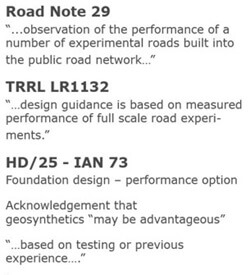
Figure 1: Confirmation from UK Highways that road design is empirical
What are the benefits of using geogrids in temporary access roads?
Many temporary access roads are needed where existing ground conditions are poor as well as variable. Often, this means that using “traditional methods”, these roads could require a significantly thick layer of stone to cater for the anticipated traffic load and will often need regular maintenance to address surface deformation and rutting.
Stabilisation geogrids can give road designers and users significant benefits in terms of reducing the thickness of the granular layer needed to build the road. This results in:
- Reduced construction cost
- Reduced construction time
- Reduced environmental impact.
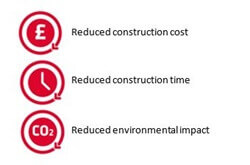
Tensar’s involvement in temporary site access road construction
Tensar geogrids have been used in temporary access road design and construction for more than 35 years. These performance-based products are developed and applied to thousands of kilometres of roadway constructed over many different ground conditions to deal with a large variation of loads.
However, it’s important to recognise that including any geogrid in a granular roadway construction doesn’t mean that savings will be available in every case.
The measurable benefits from including geogrids in temporary access roads can’t be identified simply by assessing their suitability based on parameters on a product specification sheet.
As mentioned earlier, the design of granular access roads is typically based on empirical data from testing and research. This is also the most effective way of quantifying the benefits of a geogrid in a granular road.
To this end, Tensar International in the UK have carried out a programme of nine full-scale trafficking trials at the Transport Research Laboratory (TRL), formerly the TRRL, over a 30-year period and have demonstrated the following:
• No one geogrid parameter has been identified as a good indicator of expected performance.
• The ultimate tensile strength of a geogrid is a poor indicator of expected trafficking performance, read more here.
• It’s the effect of the geogrid in combination with the granular aggregate that gives the greatest benefit to the road. This effect is known as “stabilisation”.
• Geogrid-specific “stabilisation factors” can be derived to allow the effect of a geogrid to be modelled in the temporary haul road design assessment.
Incorporating a stabilisation geogrid within a granular roadway forms what’s known as a mechanically stabilised layer (MSL). The interaction between the granular particles and the stiff geogrid structure is critical (Figures 2 and 3).
Figure 2: Granular particles confined within the stiff geogrid apertures
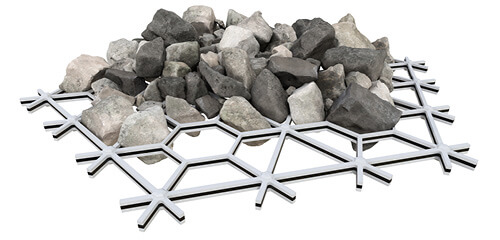.jpg)
Figure 3: A Tensar mechanically stabilised layer consisting of TriAx geogrid and granular fill
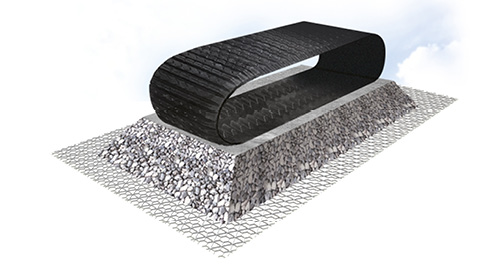
How can we quantify the benefits of geogrids for temporary site access roads
Working on weak or variable ground usually presents considerable construction challenges, therefore designing a secure mechanically stabilised layer prior to construction is essential. By using the Tensar+ subgrade stabilisation module in our geotechnical software solution, mechanically stabilised layers can be designed prior to construction, further protecting the subgrade and improving bearing capacity. Tensar’s subgrade stabilisation design methods and solutions are widely accepted and utilised worldwide.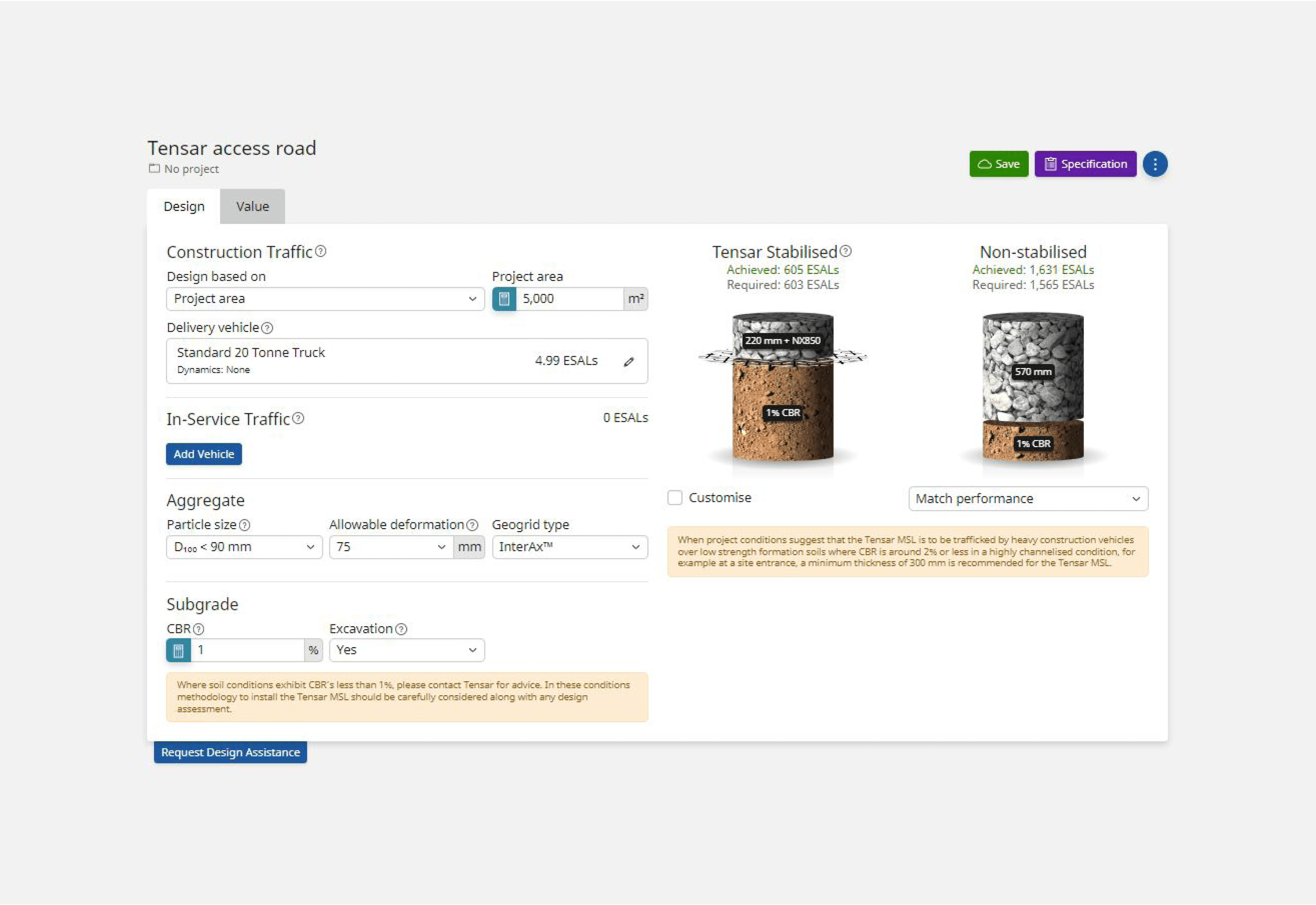
Figure 4: Tensar+ subgrade stabilisation module comparing a non-stabilised section on the right with a mechanically stabilised layer on the left
Using this software, temporary haul road designs with and without stabilisation geogrids can be compared and assessed - and savings can then be quantified. Including a stabilisation geogrid in a granular access road will reduce the required non-stabilised thickness by up to 50%.
While other mechanisms are available, they rely on tensile strength. This means deformation is likely to develop in the roadway, not just at the surface but at the level at which the reinforcement geogrid which will remain in the roadway permanently.
A stabilisation geogrid, however, doesn’t deform like a “hammock” but remains level as part of the MSL. This protects the subgrade from permanent deformation (Figure 5).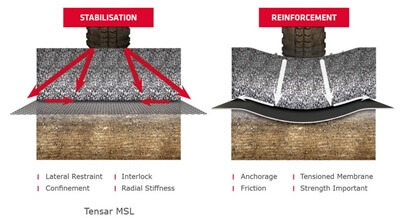
Figure 5: The difference between stabilisation and reinforcement mechanisms with geogrids
How do geogrids match project conditions?
• existing ground conditions
• anticipated traffic load
• grading of granular fill to be used in the access road
• the temporary nature of the access road
The different grades of stabilisation geogrid aren’t based on varying levels of strength, but different sizes of aperture and different product stiffness to suit specific project conditions. This means that a wide range of fill types can be used to form the MSL, from coarse fill all the way down to a sandy material (Figure 6). They can also be used on a wide variety of subgrade soils to stabilise temporary access roads to construction sites.
Visit our geogrids page to learn more.
Great Eppleton wind farm, UK
The photos here show the geogrid being installed over low-strength soils (the image below) and the finished access road once the granular fill has been placed and compacted on top of the geogrid (the image to the left).
The contractor confirmed that including the stabilisation geogrid “….allowed the construction thickness (of the access roads) to be significantly reduced and our installation was rapid and straightforward”.
Whitelee wind farm, UK
Around 45 km of access roads were required to build a large wind farm just outside Glasgow in Scotland. The ground conditions across the site consisted of low-strength and variable soils and initial site traffic would have a total weight of around 50 tonnes.
Stabilisation geogrids were incorporated into granular fill with the resulting MSL assessed to cater for the type of stone-delivery vehicle shown in the above photograph. The access roads reduced the thickness of the roadway, saving the contractor both time and money. Read more here.


